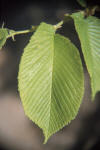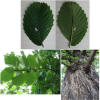WILD
FOODIES' HOME PAGE
PLANT PROFILE LIST
NAME: Slippery Elm
SPECIES / FAMILY: Ulmus Rubra / Ulmaceae
OTHER COMMON NAME(S): Red Elm
CONDITIONS: partial shade
|
PARTS: |
EDIBLE |
TASTE |
RAW/COOK |
SEASON |
|
All |
|
|
|
|
|
Shoots |
|
|
|
|
|
Leaves |
|
|
RAW/COOK |
Spring |
|
Stalk/Stem |
|
|
|
|
|
Buds |
|
|
|
|
|
Flowers |
|
|
|
|
|
Fruits |
|
|
|
|
|
Pods/Samaras |
|
|
RAW/COOK |
Spring |
|
Seeds |
|
|
RAW/COOK |
Spring/Summer |
|
Nuts |
|
|
|
|
|
Roots |
|
|
|
|
|
Bark |
|
|
DRY/GRIND/COOK |
All |
PORTION: small-medium
COMMENT: Green samaras wings and seed, raw or cooked; dried samaras winnowed of the dry wings, raw or cooked. Young leaves raw or cooked, inner bark cooked. (2) Inner bark - can be dried, ground into a powder and then used as a thickener in soups or added to cereal flours when making bread etc. It can also be chewed as a thirst quencher. The inner bark has been cooked with fats in order to prevent them becoming rancid. A tea-like beverage can be brewed from the inner bark.(1) The seeds (samaras) appear in the spring and look like little fried eggs.(4)
CAUTION: Outer bark constituents known to cause abortions - avoid during pregnancy.(1)
NUTRITION/MEDICINAL: Demulcent; Diuretic; Emollient; Expectorant; Nutritive. Slippery elm bark is a widely used herbal remedy and is considered to be one of the most valuable of remedies in herbal practice.(1)
· https://www.webmd.com/vitamins/ai/ingredientmono-978/slippery-elm
· https://draxe.com/slippery-elm
LOOK-A-LIKES:
POISONOUS LOOK-A-LIKES:
OTHER USES: Fibre; Kindling; Roofing; Tinder; Wood. A fibre obtained from the inner bark is used to make a twine. The boiled bark has been used for making matting, nets etc. The inner bark has been used in making baskets. The bark has been used as a roofing material. The weathered bark has been used as kindling for starting a fire. Wood - very close-grained, tough, heavy, hard, strong, durable, easy to split, used for fence posts, window sills, agricultural implements etc.(1) That same twisting growth made Elm perfect for wagon wheel hubs because they would not split when oak spokes were driven into them. Incidentally, the wooden rim of the wheel before covered with an iron band was made of ash because it is flexible. So a wooden wheel was made from three trees, the hub elm, the spokes oak because of strength, and the rim from ash, all held tight by a metal band put on when red hot which then shrinks as it cooled and holds everything tightly together.(2)
SOURCE LINKS (may include nutritional and medicinal info, plus other uses):



